Coordinated Control of Distributed Energy Storage Systems for DC Microgrids Coupling Photovoltaics and Batteries
Abstract
1. Introduction
2. Structure and Control Scheme of the DC Microgrid
2.1. Structure of DC Microgrid and Hierarchical Control Scheme of Bus Voltage
2.2. Components of DC Microgrid and its Control
2.2.1. PV Power Generation
2.2.2. Energy Storage Units
2.2.3. Loads of the DC Microgrid
3. SOC Equalization Strategy of DESS in the DC Microgrid
3.1. Overall Control Architecture
3.2. Enhanced Control Strategy of ESU
4. Simulation Results and Analysis
4.1. Simulation Results of DESS under Different Working Conditions
4.1.1. Scenario 1: DESS and SOC Are within Constraints
4.1.2. Scenario 2: DESS and SOC Excess Constraints
4.1.3. Scenario 3: ESU Controlled with SOC Equalization Strategy
4.2. Simulation Results of the Tracking Compensation of DESS to the PV System
4.3. Simulation Results of Sudden Load Change
5. Conclusions
- (1)
- Power fluctuation caused by sunlight conditions and load variation can be quickly stabilized, which allows the system to maintain an energy balance between supply and demand.
- (2)
- In DC microgrid systems with ESUs at different initial SOC, the proposed method can reduce the deviation between each ESU and consequently reduce the time of charging and discharging.
- (3)
- Compared with the traditional ESU control strategy, the proposed strategy is more efficient at increasing the SOC equalization speed and is more accurate when the ESU is in charging or discharging mode.
Author Contributions
Funding
Institutional Review Board Statement
Informed Consent Statement
Data Availability Statement
Conflicts of Interest
Nomenclature
| Symbols | |
| L | inductor |
| Si | switches |
| Di | diodes |
| Ci | filter capacitors |
| Ubat | output voltage of the energy storage system |
| Udc | DC bus voltage |
| iD(t) | diodes current |
| iL(t) | inductor current |
| uD(t) | inductor voltage |
| uR(t) | load voltage |
| Abbreviations | |
| ESU | energy storage unit |
| ESS | energy storage system |
| DESS | distributed energy storage system |
| SOC | state of charge |
| PV | photovoltaic |
| MPPT | maximum power point tracking |
References
- Krishnamoorthy, M.; Periyanayagam, A.D.V.R.; Santhan Kumar, C.; Praveen Kumar, B.; Srinivasan, S.; Kathiravan, P. Optimal sizing, selection, and techno-economic analysis of battery storage for PV/BG-based hybrid rural electrification system. IETE J. Res. 2020, 68, 4061–4076. [Google Scholar] [CrossRef]
- Eric, H.; Ted, W.; John, K.; Jay, W. Evaluating the value of batteries in microgrid electricity systems using an improved Energy systems model. Energy Convers. Manag. 2015, 89, 458–472. [Google Scholar]
- Li, X.; Sun, K.; Josep, M.G. State-of-Charge balance using adaptive droop control for distributed energy storage systems in DC microgrid applications. IEEE Trans. Ind. Electron. 2013, 61, 2804–2815. [Google Scholar]
- Zhang, S.; Qin, W.; Ren, C. Control strategy for hybrid energy storage system in bipolar-type DC micro-grid. High Volt. Eng. 2018, 309, 2761–2768. [Google Scholar]
- Mendis, N.; Muttaqi, K.M.; Perera, S. Management of battery-supercapacitor hybrid energy storage and synchronous condenser for isolated operation of PMSG based variable-speed wind turbine generating systems. IEEE Trans. Smart Grid 2014, 13, 12–24. [Google Scholar] [CrossRef]
- Ye, Z.; HongJie, J.; Li, G. Energy Management Strategy of Islanded Microgrid Based on Power Flow Control. In Proceedings of the 2012 IEEE PES Innovative Smart Grid Technologies, Washington, DC, USA, 16–20 January 2012; pp. 1–8. [Google Scholar]
- Li, P.; Zhang, C.; Yuan, R. Load current sharing method of distributed energy storage systems by improved SOC drooping control. Proc. CSEE 2017, 37, 3746–3754. [Google Scholar]
- Zhang, J.; Sun, J.; Ning, J. Coordinated control for PV/Storage hybrid islanded microgrid considering SOC balancing. Trans. China Electrotech. Soc. 2018, 33, 527–537. [Google Scholar]
- Sahoo, S.; Mishra, S.; Padhy, N.P. A Decentralized Adaptive Droop Based Power Management Scheme in Autonomous DC Microgrid. In Proceedings of the 2016 IEEE PES Asia-Pacific Power and Energy Engineering Conference (APPEEC), Xi’an, China, 25–28 October 2016. [Google Scholar]
- Chen, T.; Xu, X.; Zhu, Y. Optimal operation based on deep reinforcement learning for energy storage system in photovoltaic-storage charging station. Electr. Power Autom. Equip. 2021, 41, 90–98. [Google Scholar]
- Jun, C.; Dan, H.; Fan, Z.; Thomas, M.; David, H.; Kang, L. Deep reinforcement learning based energy storage arbitrage with accurate lithium-ion battery degradation model. IEEE Trans. Smart Grid. 2020, 11, 4513–4521. [Google Scholar]
- Liu, H.; Luo, X.; Zhang, W.; Liu, Y.; Sun, W.; Guo, M. Research on DC microgrid coordinated control strategy considering battery SOC. Electrotech. Appl. 2020, 39, 16–23. [Google Scholar]
- Zhang, H.; Duan, J.; Xi, Y.; Gong, X.; Cheng, X. AGC model predictive control of islanded HVDC sending end considering SOC recovery of energy storage. Electr. Power Autom. Equipment. 2021, 41, 199–204. [Google Scholar]
- Anderson, P.M.; Mirheydar, M. A low-order system frequency response model. IEEE Trans. Power Syst. A Publ. Power Eng. Soc. 1990, 5, 720–729. [Google Scholar] [CrossRef]
- Li, S.; Li, X.; Kang, Y.; Gao, Q. Load capability assessment and enhancement for transformers with integration of large-scale renewable energy: A. brief review. Front. Energy Res. 2022, 10, 1002973. [Google Scholar] [CrossRef]
- Jiang, Z.; Li, S.; Ma, X.; Li, X.; Kang, Y.; Li, H.; Dong, H. State estimation of regional power systems with source-load two-terminal uncertainties. Comput. Model. Eng. Sci. 2022, 132, 295–317. [Google Scholar] [CrossRef]
- Li, X.; Li, H.; Li, S.; Jiang, Z.; Ma, X. Review on reactive power and voltage optimization of active distribution network with renewable distributed generation and time-varying loads. Math. Probl. Eng. 2021, 2021, 1196369. [Google Scholar] [CrossRef]
- Liu, J.; Han, X.; Wang, L.; Zhang, P.; Wang, J. Operation and control strategy of DC microgrid. Power Syst. Technol. 2014, 38, 2356–2362. [Google Scholar]
- Kollimalla, S.K.; Mishra, M.K. A New Control Strategy for Interfacing Battery Supercapacitor Storage Systems for PV System. In Proceedings of the 2014 IEEE Students’ Conference on Electrical, Electronics and Computer Science, Lakes-Bhopal, India,, 1–2 March 2014. [Google Scholar]
- Georgious, R.; Garcia, J.; Navarro-Rodriguez, A.; Garcia, P. A study on the control design of nonisolated converter configurations for hybrid energy storage systems. IEEE Trans. Ind. Appl. 2018, 54, 4660–4671. [Google Scholar] [CrossRef]
- Yuan, N.; Wang, Y.; Zhang, J.; Zhang, W. Improved droop control based on SOC in DC microgrid. Power Syst. Prot. Control 2019, 47, 17–23. [Google Scholar]
- Alam, M.; Kumar, K.; Dutta, V. Droop based control strategy for balancing the level of hydrogen storage in direct current microgrid application. J. Energy Storage 2020, 33, 102106. [Google Scholar] [CrossRef]
- Lang, J.; Cheng, Q.; Zhang, Z.; Zheng, S. Research on SOC-based droop control in optical storage microgridy. Ind. Control. Comput. 2020, 33, 134–136. [Google Scholar]
- Li, D.; Liang, L.; Li, S. Coordinated control strategy for isolated DC microgrid with hybrid energy storage system. Renew. Energy Resour. 2020, 38, 524–531. [Google Scholar]
- Wu, Z.; Liu, X.; Li, C.; Yang, X. Coordinated control strategy in micro-grid with the limit value of battery SOC. Electr. Meas. Instrum. 2015, 52, 62–67. [Google Scholar]
- Liu, Q.; Fan, S.; Chao, F.; Li, C. Energy management of isolated micro-grid with wind turbines, energy storage and seawater desalination devices considering different battery SOC state. High Volt. Eng. 2015, 41, 2173–2179. [Google Scholar]
- Mohamed, S.; Mokhtar, M.; Marei, M.I. A Control Strategy for Hybrid Islanded Microgrid. In Proceedings of the 2019 21st International Middle East Power Systems Conference (MEPCON), Cairo, Egypt, 17–19 December 2019. [Google Scholar]
- Oh, H.; Hwang, T.; Lee, S. A simplified simulation model of RO systems for seawater desalination. Desalination 2018, 238, 128–139. [Google Scholar] [CrossRef]
- Wu, Q.; Sun, X.; Hao, Y. Research of SOC balance and voltage frequence recovery of microgrid energy storage system. ACTA Energ. Sol. Sin. 2018, 39, 1743–1751. [Google Scholar]
- Yun, Z.; Chen, W.; Yi, W. SOC dynamic balancing strategy for multi-energy storage based on adaptive droop control in DC microgrid. J. North China Electr. Power Univ. (Nat. Sci. Ed.) 2020, 47, 21–29. [Google Scholar]
- Li, J.; Liu, X.; Zhang, Y.; Zhang, W.; Yin, Y.; Hao, S.; Lv, G. Accurate power distribution and bus voltage deviation optimization control of DC microgrid based on adaptive droop algorithm. Power Capacit. React. Power Compens. 2021, 42, 164–169. [Google Scholar]
- Khorsandi, A.; Ashourloo, M.; Mokhtari, H. A decentralized control method for a low-voltage dc microgrid. IEEE Trans. Energy Convers. 2014, 29, 793–801. [Google Scholar] [CrossRef]
- Yang, X.; Yin, C. Coordinated control strategy of light storage and DC microgrid based on islanding mode. Electr. Drive 2020, 50, 75–80. [Google Scholar]
- Guo, X.; Li, L.; Wu, L. Frequency modulation strategy of hybrid energy storage system of microgrid based on droop control. Power Capacit. React. Power Compens. 2021, 42, 176–182. [Google Scholar]
- Zhu, Y.; Wang, Z.; Wang, H.; Wei, D.; Shao, N.; Jiang, X. Research on hierarchical control of micro power grid hybrid energy storage coordination optimization strategy. ACTA Energ. Sol. Sin. 2021, 42, 235–242. [Google Scholar]
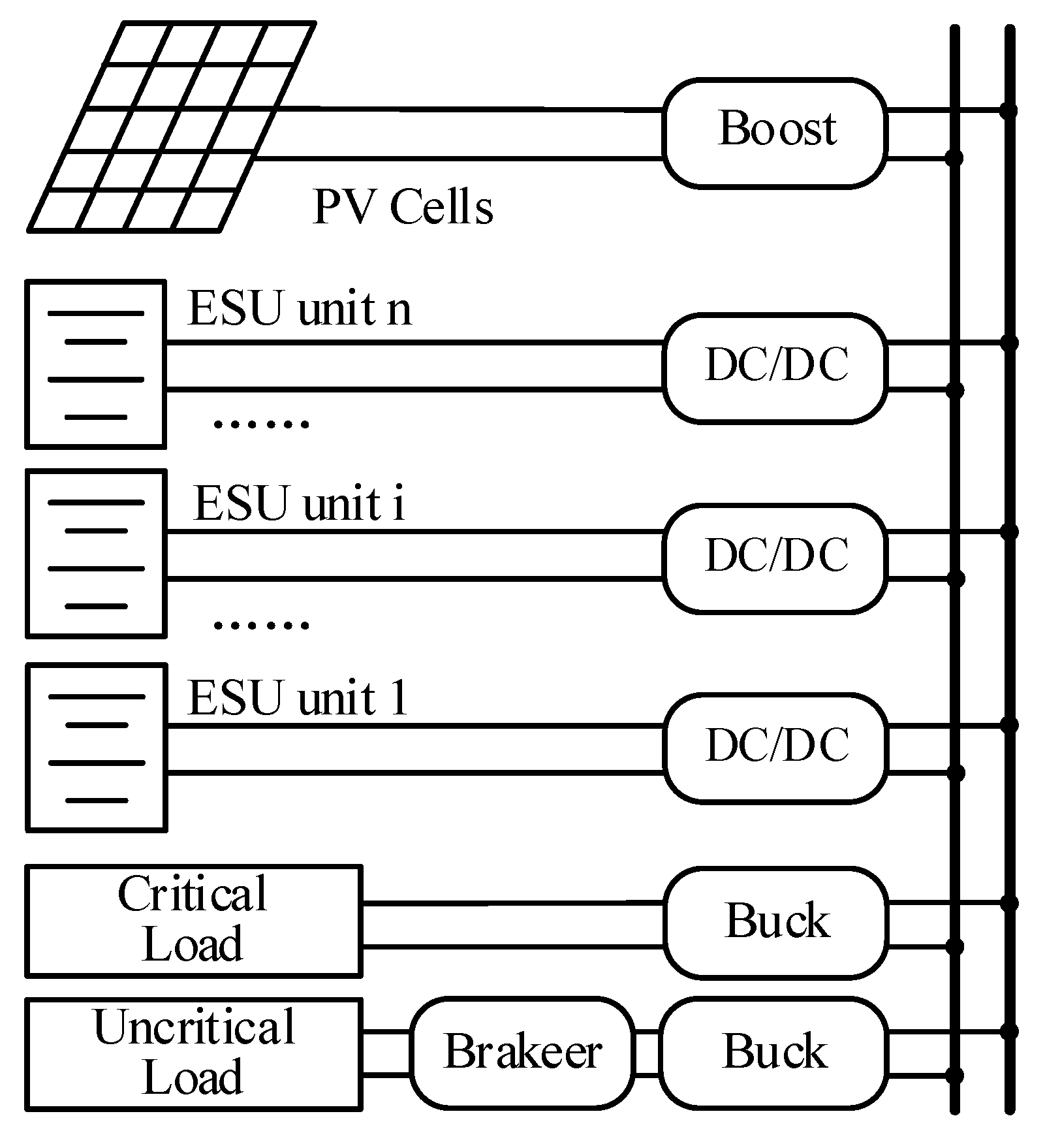
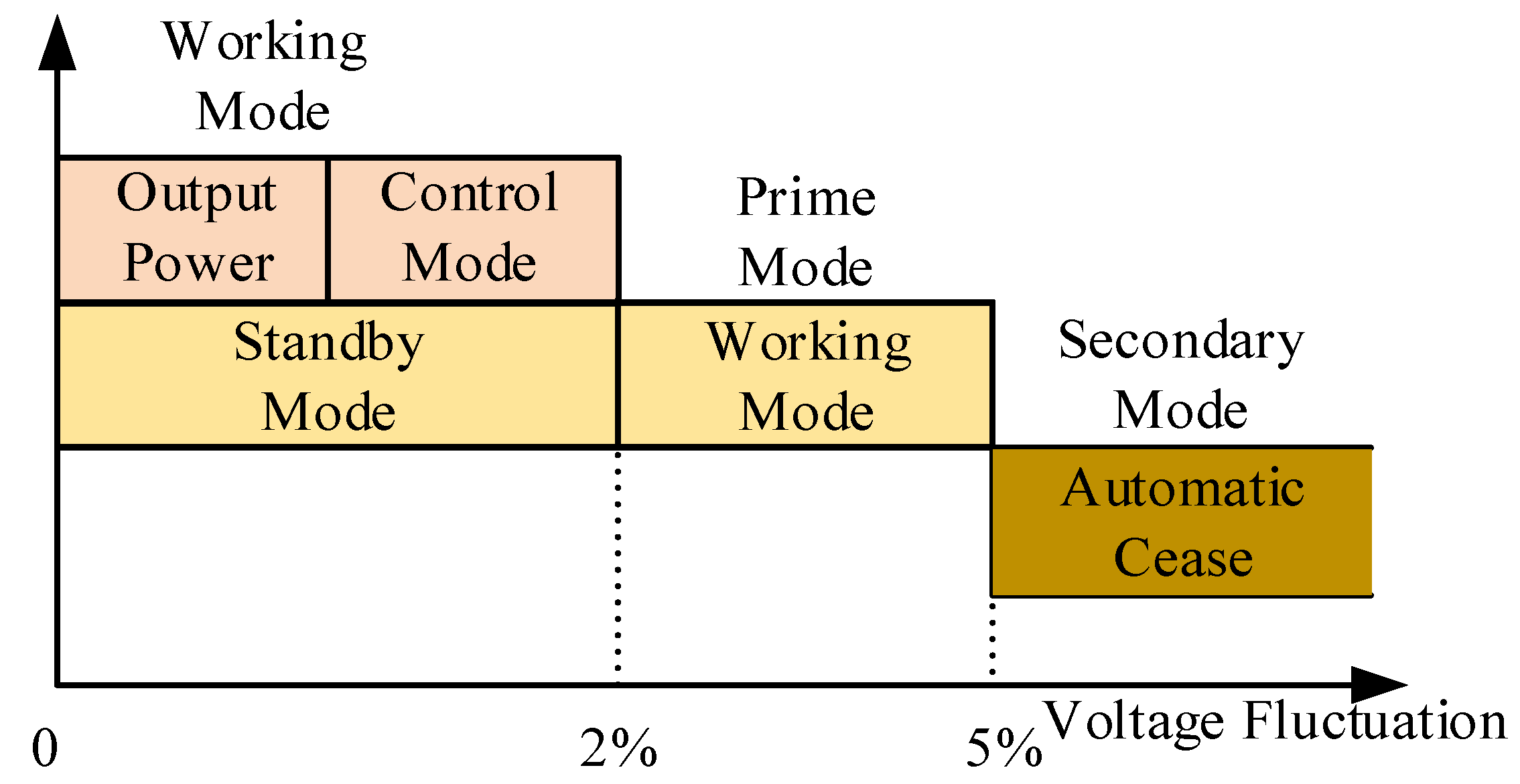

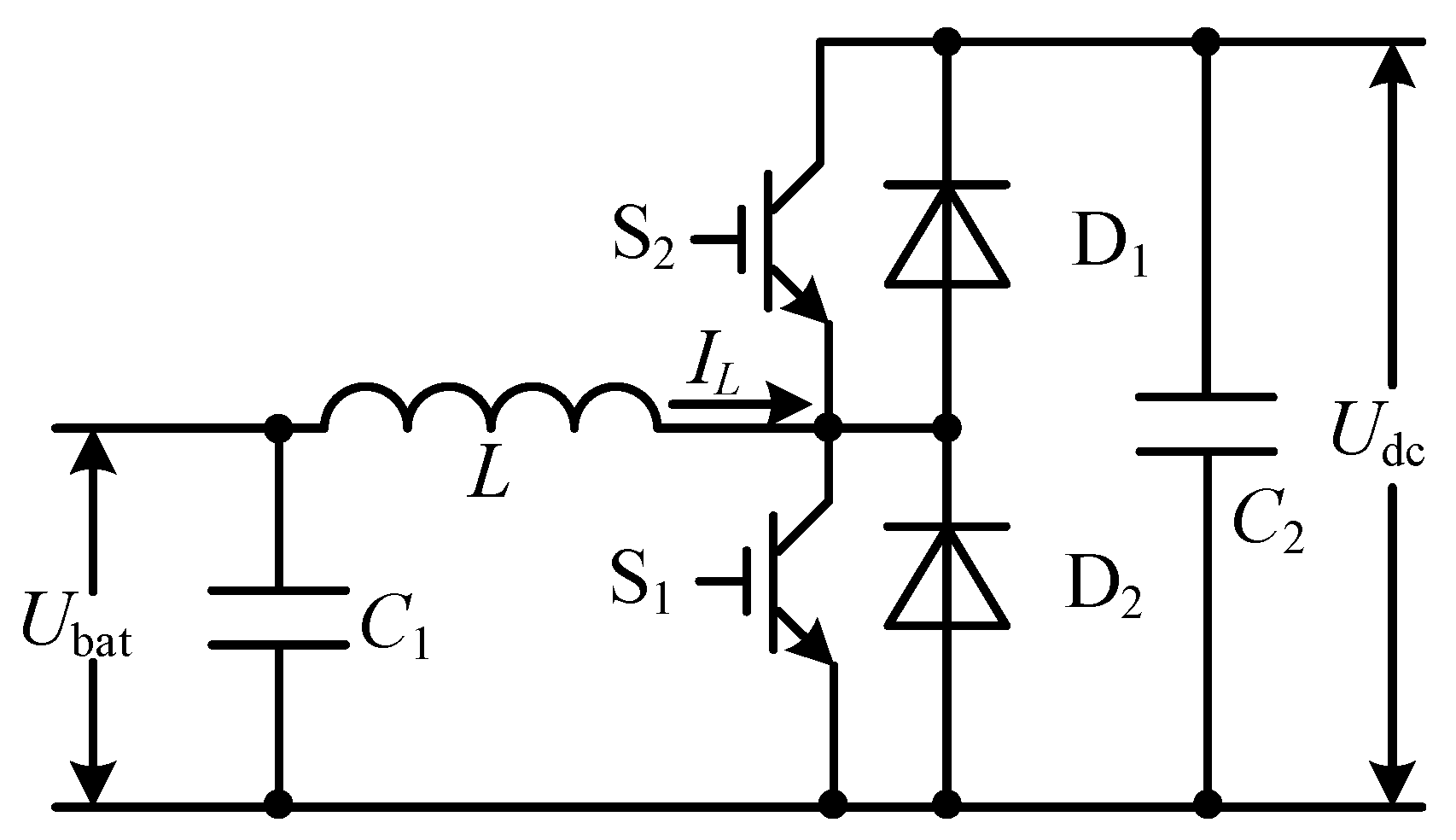

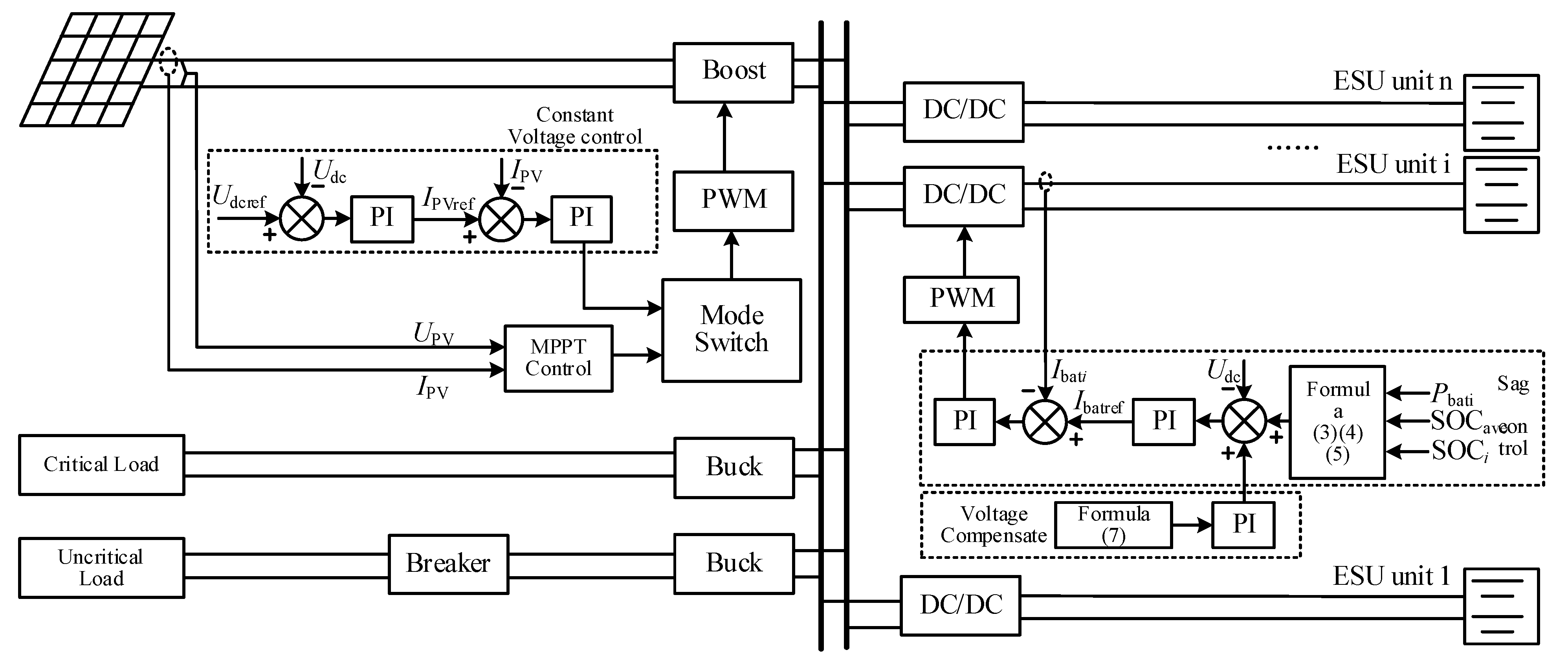
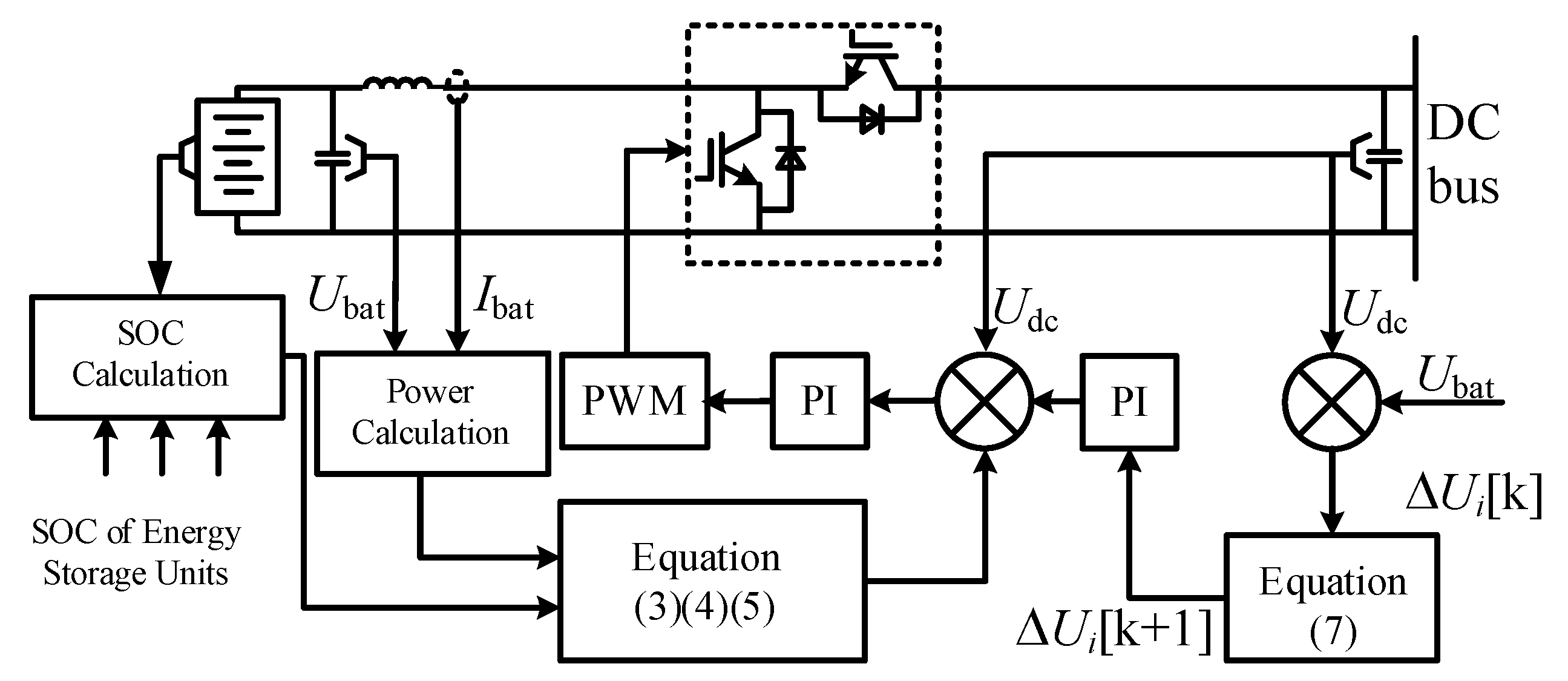

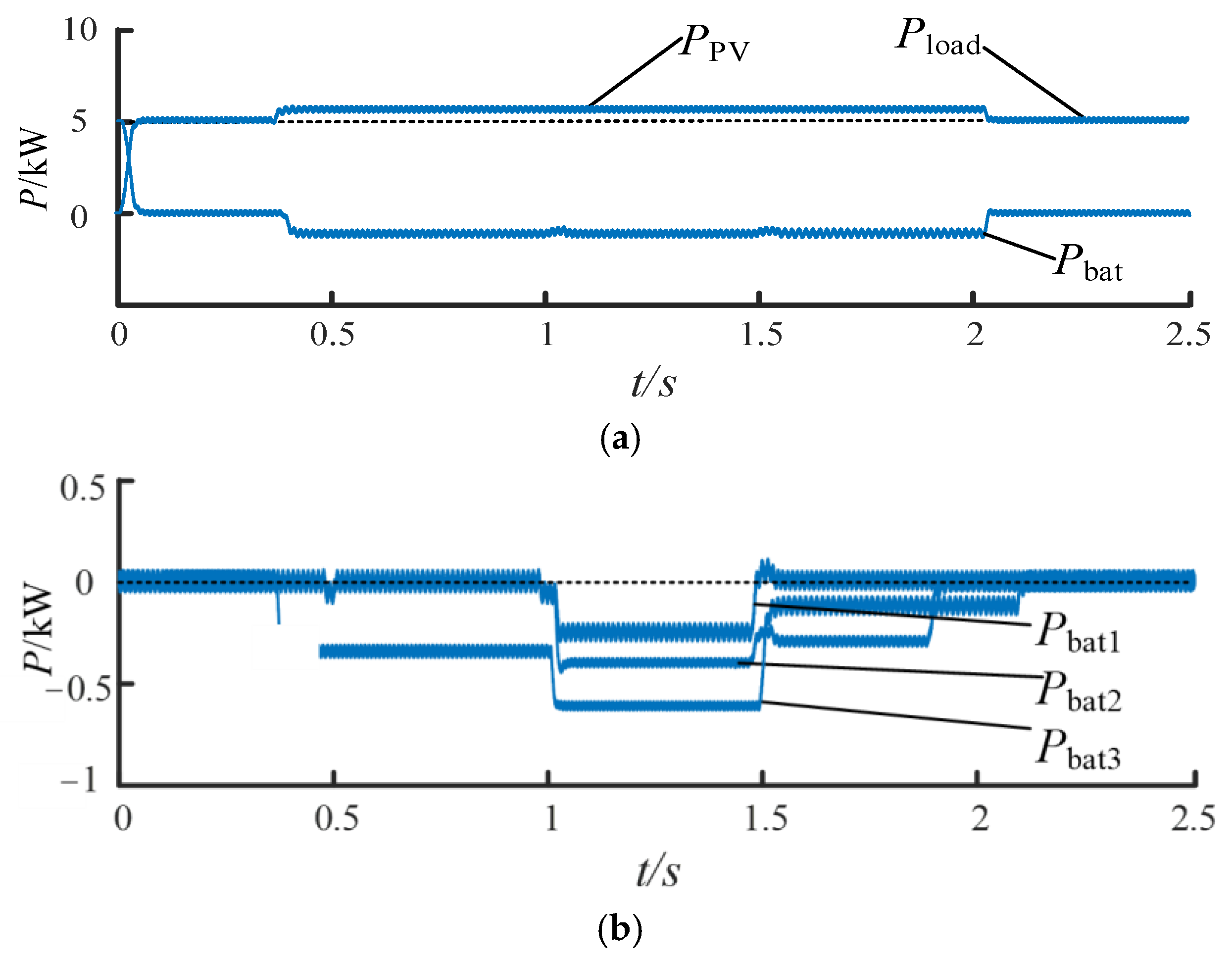

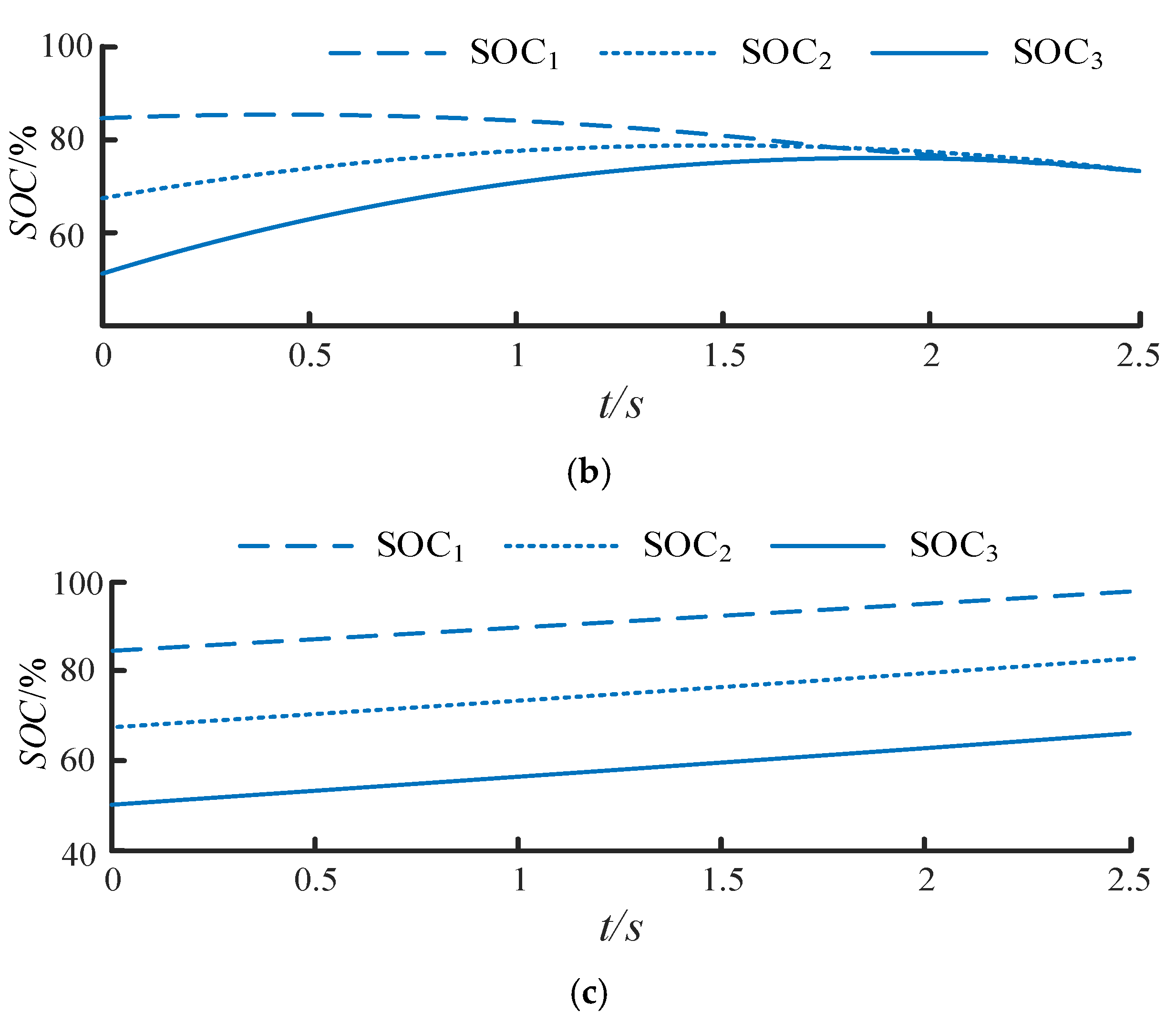



Disclaimer/Publisher’s Note: The statements, opinions and data contained in all publications are solely those of the individual author(s) and contributor(s) and not of MDPI and/or the editor(s). MDPI and/or the editor(s) disclaim responsibility for any injury to people or property resulting from any ideas, methods, instructions or products referred to in the content. |
© 2023 by the authors. Licensee MDPI, Basel, Switzerland. This article is an open access article distributed under the terms and conditions of the Creative Commons Attribution (CC BY) license (https://creativecommons.org/licenses/by/4.0/).
Share and Cite
Zhang, Q.; Song, Z.; Ru, Q.; Fan, J.; Qiao, L.; Li, M.; Wang, L.; Li, S. Coordinated Control of Distributed Energy Storage Systems for DC Microgrids Coupling Photovoltaics and Batteries. Energies 2023, 16, 665. https://doi.org/10.3390/en16020665
Zhang Q, Song Z, Ru Q, Fan J, Qiao L, Li M, Wang L, Li S. Coordinated Control of Distributed Energy Storage Systems for DC Microgrids Coupling Photovoltaics and Batteries. Energies. 2023; 16(2):665. https://doi.org/10.3390/en16020665
Chicago/Turabian StyleZhang, Quan’e, Zhigang Song, Qiushi Ru, Jiangwei Fan, Lihui Qiao, Mingche Li, Licheng Wang, and Shuaibing Li. 2023. "Coordinated Control of Distributed Energy Storage Systems for DC Microgrids Coupling Photovoltaics and Batteries" Energies 16, no. 2: 665. https://doi.org/10.3390/en16020665
APA StyleZhang, Q., Song, Z., Ru, Q., Fan, J., Qiao, L., Li, M., Wang, L., & Li, S. (2023). Coordinated Control of Distributed Energy Storage Systems for DC Microgrids Coupling Photovoltaics and Batteries. Energies, 16(2), 665. https://doi.org/10.3390/en16020665







